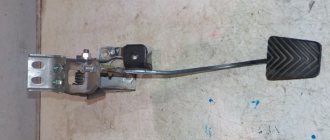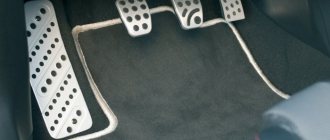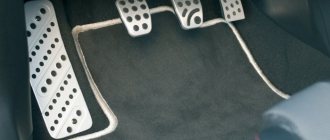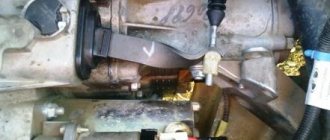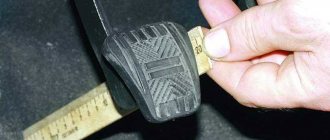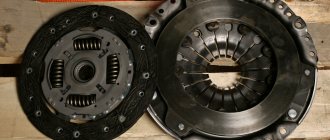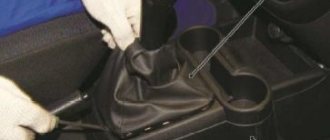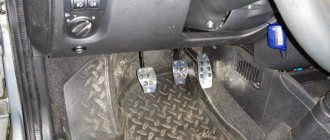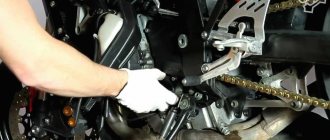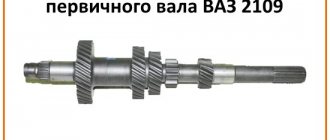Clutch pedal creaks - prerequisites and methods for solving the problem
Hi all. Not long ago I talked about the reasons for the failure of the clutch pedal, as well as methods for solving this phenomenon. Now I’ve decided to supplement the series of articles on the clutch with another, no less pressing topic - the creaking of the clutch pedal.
You will learn about the reasons why the clutch pedal squeaks and how to get rid of it.
I’ll say right away that the creaking of a pedal, whether it’s a clutch or a brake, almost always does not affect its functionality and, by and large, is an ordinary irritant that infuriates almost all motorists. The creaking or grinding of pedals occasionally indicates serious breakdowns, but before you give up on it with the words “I still have nerves of steel,” I recommend making sure that the problem is really not worth attention.
Advice!
Struts and shock absorbers ss20 for the front and rear suspension of VAZ 2108-2110, Lada Priora, Lada Kalina, Lada Granta
The clutch pedal should be installed at the level of the other two, otherwise there is a chance that the reverse gear simply will not engage.
If all the manipulations to lubricate all rubbing parts and mechanisms did not help you, and the problem remains unresolved, then in such a situation the best option would be to contact a specialized service center for diagnostic analysis.
Because solving problems with the gearbox and clutch in advance can prevent you from unexpected breakdowns and further expensive repairs.
- For lubricants in hard-to-reach areas, it is best to use WD-40 or a silicone lubricant in spray form. Thus, the material will be better distributed on the surface and will reach all places that are difficult to reach manually.
- It is recommended to lubricate the clutch pedal and fork cable fastenings with graphite lubricant, which has a beneficial effect on such mechanisms and holds well on devices subject to constant load.
Clutch pedal creaking - prerequisites
The main prerequisite in the vast majority of cases is the drive, which can be either mechanical or hydraulic. The force you exert on the pedals is transmitted to the clutch fork by means of a cable or hydraulic system. Despite the fact that hydraulic and mechanical drives have different designs, their creaking is monotonous. On models such as: VAZ 2110, 2112, 2114, 2115, a mechanical cable clutch is installed. In some models, in order to compensate for friction lining wear, the manufacturer installs a mechanism that does not require adjustment. This clutch is equipped with: Priora, Granta, and also Kalina.
When the driver notices that the clutch pedal is creaking, this already means that the problem has reached a certain point. Creaking is associated with excessive wear of working parts (for example, the fastening mechanism), water ingress on rubbing surfaces, and other reasons for which increased friction occurs. Often, pedal squeaking occurs due to the return mechanism.
Such sounds most often appear not when pressing, but when releasing the pedal, just at the moment when the clutch mechanism is released from overload. If we talk about the pedal assembly, then only mechanical connections and the return spring can creak there. The problem of the creaking itself is unpleasant because it is very difficult to get to the pedal block. Working in a confined space is not easy, because the work requires a lot of strength and patience.
The clutch pedal squeaks due to wear on the mounting mechanism. For most VAZ models, the pedals are mounted on hinged mounts and axles. Either a plastic bushing or lubricant is responsible for the pedal sliding on the axle. By and large, plastic bushings do not anticipate the presence of lubricant, but if you still add it, it won’t be worse. A squeaking clutch pedal can appear even on the newest cars, in which everything is working properly. You can remove creaking and grinding noises by applying lubricant or replacing the bushing and spring; the most important thing is to find where exactly the creaking is coming from. The lubrication itself is carried out after complete dismantling of the pedal block together with all mechanisms. The work is complicated by the fact that the dismantling process takes a lot of time and is considered very labor-intensive. If you don't want to remove all the pedals, you can try lubrication using a syringe. Apply oil to the rubbing parts, inside the bushings, and also where you think it is necessary. We remove the remaining lubricant with a rag, after which we check whether the clutch pedal squeaks or not.
If after lubrication nothing has changed, you can imagine that the reason is in the return spring. The spring may hit something or creak on its own. We lubricate the spring, if necessary, with silicone grease or WD-40, but the effect will most likely be short-term. Therefore, it is better to use the most severe lubricants such as graphite or CV joint lubricant.
The cable creaks. In some cases, creaking, grinding and clicking noises are associated with disturbances in the operation of the mechanical drive. The problem in this case is that the cable can creak both outside and inside the cabin. Full lubrication of the cable along its entire length will help correct this situation. The procedure is not difficult and does not take much time, so if this is the reason, then you can consider yourself lucky. For convenience, the cable is disconnected from the clutch fork, after which it is lubricated from the engine compartment. If the cable is old and shows signs of wear, lubrication is unlikely to be advisable, it would be better if you completely replace the clutch cable. Unprotected working surfaces of the cable that are outside the protective casing should be lubricated with waterproof grease.
The creaking of the compensatory mechanism. If the car has such a mechanism (it is located under the hood or near the pedal), the new cable can make unpleasant sounds and clicks, similar to squeaking or grinding. The problem in this situation is due to the fact that the mechanism is not worn in and requires lubrication of the compensation mechanism.
If the creaking of the VAZ clutch pedal is not associated with any of the problems listed above, there is a suspicion that unpleasant sounds are generated in the crankcase area. Such a squeak can be produced, for example, by the clutch fork. The difficulty in this situation is that it is possible to check whether the problem is or not only after completely dismantling the clutch. There are indeed some tricks like lubrication without removal, but they require certain skills and accuracy. The trick and dexterity lies in the ability to lubricate the fork with oil without removing the checkpoint (Checkpoint - a point designed to control passage (visit) and access to the territory of any facility)
. But if it is not the fork that is creaking, but another mechanism, the quickest way is to remove it.
The fork is lubricated as follows. We take out the rubber plug, then fill the syringe with lubricant and carefully apply a few drops to the clutch fork axle. For cars whose forks do not have an axle, lubrication occurs a little differently. Using a strong screwdriver or mounting tool, the fork is moved to the side, after which it is lubricated with a thick lubricant like “Litol” at the point of contact of the fork with the rod.
Source: vaz-remont.ru
Other causes of squeaking
If everything is perfect in the calculations, but the unpleasant sound does not leave you behind, then you need to look for other culprits:
- Plastic pedal bushing. It can “get used” to the bracket and make squeaks. Everything is quite simple here, we are looking for the attachment point, it is probably loose. Let's pull it up. Then be sure to repeat the procedure with the cable
- Tip lead. You will notice this at the first stage. If it squeaks, then it needs to be changed. Fortunately, there are plenty of such parts on sale, and the replacement process itself is not difficult. Unscrewed the old one and screwed on the new one. Then again measure and adjust according to the instructions above
- Loss of input shaft lubrication. This is already a problem with the box itself. Here the solution is clear: lubricant.
If you have carried out all these repairs, but still haven’t gotten rid of the problem, then the best advice would be to visit a car service center or an official dealer. Tell the technician what you tried to fix on your own, but did not achieve results. Then he will immediately look in other places and will not spend much time on repairs.
Clutch pedal creaking on the latest Priora
Because you are not authorized on the website. To come in.
Because you are not a trusted user. How to become a trustee.
Because The topic is archived.
Because you are not authorized on the website. To come in.
Because you are not a trusted user (phone number not verified). Enter and confirm your phone number. Read more about trusts.
Because The topic is archived.
Because you are not authorized on the website. To come in.
Because you are not a trusted user (phone number not verified). Enter and confirm your phone number. Read more about trusts.
Because The topic is archived.
Because you are not authorized on the website. To come in.
Because you are not a trusted user (phone number not verified). Enter and confirm your phone number. Read more about trusts.
Because The topic is archived.
Because you are not authorized on the website. To come in.
Because you are not a trusted user (phone number not verified). Enter and confirm your phone number. Read more about trusts.
Because The topic is archived.
Because you are not authorized on the website. To come in.
Because you are not a trusted user (phone number not verified). Enter and confirm your phone number. Read more about trusts.
Because The topic is archived.
Because you are not authorized on the website. To come in.
Because you are not a trusted user (phone number not verified). Enter and confirm your phone number. Read more about trusts.
Because The topic is archived.
Because you are not authorized on the website. To come in.
Because you are not a trusted user (phone number not verified). Enter and confirm your phone number. Read more about trusts.
Because The topic is archived.
Because you are not authorized on the website. To come in.
Because you are not a trusted user (phone number not verified). Enter and confirm your phone number. Read more about trusts.
Because The topic is archived.
Because you are not authorized on the website. To come in.
Because you are not a trusted user (phone number not verified). Enter and confirm your phone number. Read more about trusts.
Because The topic is archived.
Because you are not authorized on the website. To come in.
Because you are not a trusted user (phone number not verified). Enter and confirm your phone number. Read more about trusts.
Because The topic is archived.
Because you are not authorized on the website. To come in.
Advertisements on NN.RU – Auto
Extend the chassis (frame) on Gazelle Next, Gazelle peasant under a body of 4.2 m, 5.1 m and 6.2 m. Extend the frame on Gazelle Next, Gazelle Gas 3302. Cost: 25,000 rubles.
The company allows you to upgrade the Fiat Ducato Fiat Ducato basic version for a solution.
A wide selection of hydraulic pumps and hydraulic motors of all series: spline hydraulic pump of right rotation. It is used in road construction and... Cost: 1,000 rub.
The broken-type towing platform produced in our company has the highest design reliability, which is confirmed by its longevity.
Source: www.nn.ru
Diagnosing and eliminating squeaking clutch pedal
The clutch is one of the most important devices in a car. This mechanism ensures the transmission of the torque of the car's engine to the driven disk through the clutch basket. The clutch disc is in constant contact with the flywheel using a spring mechanism. It is subject to the action of a release bearing, the function of which is to disconnect the torque of the motor from the driven disk when you press the pedal. Like all vehicle elements, the clutch is subject to wear and various types of problems.
Car owners often do not take into account the existing creaking of the clutch pedal. In fact, this may indicate a number of severe defects. Photo: autoskipper.ru
What to do?
A question that torments every car owner, but everyone has their own problem. If we talk about creaking, then you need to understand what further operation will lead to. If it seems that when you press the pedal the fork will break, then it is better to carefully drive to a car service center and give the car to specialists. If everything is fine with the pedal, it works as always, then you can drive until everything becomes obvious.
What should you do yourself? If the car owner knows the design of his car, then it will not be difficult for him to get to the clutch on his own and figure out the problem. But the problem could also be in the pedal. It is this that a person constantly acts on, so it is worth checking the return mechanism, or rather, looking at the condition of the spring. Fortunately, there is a lot of space in the Hyundai Solaris and anyone can do it.
The clutch pedal on all cars weighs on a bracket and is mounted on an axle. Inside they have plastic bushings that can provide easy pedal travel. Often these are the ones that wear out.
It’s worth noting that they are plastic, so you shouldn’t lubricate them, it won’t help anyway. They need to be changed immediately.
To eliminate light squeaks that do not affect the forks or cable, you just need to unharness the spring and remove the entire pedal unit. While all this is in this state, you can take the opportunity to lubricate the pedal. The only problem may be that the creaking appears most often in winter, and the procedure can take quite a long time. But it’s better than hearing this creak when pressed. If you don’t want to do this, then, of course, you can try to lubricate the bushings. However, it is not certain that this will help.
If, which is quite logical, the creaking remains and has not even lost its volume, then you need to look for the reason in the return spring, and it can creak on its own. Lubricating or dripping WD-40 is not a good idea. Not worth the word “at all”. It is best to use a CV joint; such lubricant is sold in tubes, which is very convenient. Experts say that this eliminates squeaking in 99 cases out of 100.
Causes of a squeaking clutch pedal
The source of pedal squeaking is the clutch drive. On the most expensive car models, the clutch drive is hydraulic. In Russian-made cars, a mechanical drive is installed. The difference between the devices is that in the first type, the force transmitted from the pedal to the clutch fork is carried out through a hydraulic system, which is supplemented by an amplifier. The operation of the mechanical drive is ensured by a cable mechanism and a compensation mechanism.
There are two types of defects associated with clutch squeaking:
- Insignificant creak. It occurs when you press and release the clutch pedal. This type of appearance of third-party sounds does not pose any threat to either punishment or the safety of the driver and passengers. The only thing that is possible is boredom from the constant nasty sound and irritation of the nervous system of the owner of the car. The consequence of this type of clutch squeaking can be severe winter weather conditions, characterized by severe frosts. But the creaking has a fickle temperament. When the engine and interior of the car warm up, the pedal and the entire clutch mechanism come into a smooth, serviceable state.
- The malfunction is accompanied by a hard and loud squeaking sound from the clutch during operation. The clutch pedal is pressed tightly and turns jerkily or very slowly. Such a malfunction carries the risk of breaking the clutch cable or damaging its fork. If you experience these symptoms, you should immediately contact a service station to have the problem diagnosed and repaired by highly qualified auto mechanics.
A prerequisite for the appearance of squeaks when operating the clutch pedal can also be an insufficient amount of lubricants on all surfaces of the working parts moving and rubbing against each other. Photo: avtodelkino.ru
Eliminating a squeaking clutch pedal
First, to eliminate the creaking of the clutch pedal, you need to carry out a number of measures related to the lubrication of the entire pedal assembly of the car. Any car owner can do them. When lubricating the pedal assembly, you need to pay attention to the clutch bushings. Motor oil is dripped into them using a syringe. In addition, it is necessary to pay attention to the return spring. The popular WD-40 is perfect for lubricating it. The second option, not the worst, is a lubricant created for the CV joint (constant velocity joint).
You will learn more about the news from Mitsubishi – Eclipse Cross – in this material.
Also here you will find a video of the KIA Mohave test drive.
For the most confident car enthusiasts who have extensive experience in repairing cars, it is recommended to disassemble the entire pedal assembly and get to the clutch release fork. It needs to be inspected for flaws. If they are identified, then the plug must be replaced with a new one. In addition, it is necessary to lubricate the cable, which is located under the rubber gasket, having previously cleared it of accumulated debris. This becomes especially important if the cable is outdated. The newest cable, which is in good condition, does not require lubricants. In order to lubricate the cable, various water-repellent consistencies, namely lithium, are ideal.
There are two points of view regarding the operation of the clutch cable. Some car owners believe that when the clutch pedal squeaks, you just need to change the cable to a new one. But they forget that it must be lubricated before installation. Other drivers say that clutch cables should not be lubricated under any circumstances. They argue this by saying that over time, a layer of dust and sand appears on the cable, which destroys it. Despite these statements, in practice a cable that is lubricated serves for a long time and without failure.
It is necessary to inspect the clutch fork boot and change it if necessary. Photo: blogspot.com
In addition, it is necessary to inspect the clutch fork for the presence of vertical movements, which are explained by a design flaw in the mechanism. The consequence of such a problem will be a downward displacement of the fork, due to which the bearing will begin to wear out, the friction of which will occur on the input shaft. This problem can be solved by installing the fork in space using round spacers.
If, after lubricating the cable and repairing the clutch release fork, the squeaking noise during pedal operation is not eliminated, then the compensation mechanism should be examined. It can be placed either next to the clutch (under the hood) or near the pedal. It depends on the car model. Using a syringe, apply a few drops to the compensatory mechanism.
Inattentive operation of the vehicle, namely ignoring such a malfunction as the squeaking of the clutch pedal, is an absolute threat to the driver and passengers. Therefore, it is necessary to take timely measures to identify the circumstances and carry out repairs. Thus, a faulty fork leads to failure of the entire clutch mechanism. The friction linings that are located on the clutch disc will wear out quickly over time. If the linings are completely worn out, the car simply will not be able to move. The same applies to the clutch cable. If you do not take timely care of the clutch mechanism, in an instant when changing gears from one to another, the clutch cable may break. In this case, the clutch pedal itself falls to the floor, and the driver may lose control of the uncontrollable car.
You will find one of the options for eliminating the squeaking clutch pedal in this video:
The clutch is an important part of the car, without which its real functioning is impossible. Any signs of problems in it should immediately attract the attention of the car owner. Creaking when the clutch pedal operates may indicate wear on the cable, the need to lubricate the pedal assembly, or a malfunction of the clutch release fork.
Source: procrossover.ru
The essence of the problem
Everyone decides to fight this scourge on their own, using their own resources (using the “scientific” method) or uses the advice of experienced “logan breeders” who have conquered this terrible “melody”. In this article you will learn about where this squeak comes from and how to cure it with your own hands.
We are looking for the cause
In fact, based on the design of the Renault Logan clutch, creaking can come from anything, from the bolt securing the pedal together with the spring, to the clutch basket with the release bearing. Such problems begin to appear from least to greatest after only kilometers of driving.
We are looking for a solution
Replace the clutch cable if it shows signs of mechanical stress and damage.
If the car's mileage is not too high and there are no problems with the clutch, first of all, pay attention to the condition of the transmission pedal cable. Visual damage, tears and corrosion are the determining indicators for its replacement.
This spring needs to be lubricated first.
If the cable is intact, then it is recommended to treat all rubbing surfaces (including the pedal spring) with silicone grease or WD-40. If such manipulations do not solve the problem, then it is necessary to look for it through the engine compartment, removing that same cable and replacing it with a new one. If this does not help, then the clutch assembly will need to be replaced.
PS
Remember that during operation, during operation, it is not the clutch cable itself that fails, but its casing, which wears out much faster. Therefore, when buying new parts, choose the highest quality of all.
Individuality of the Lada Priora clutch
Any motorist who is interested in how to adjust the clutch on a Priora should know about the presence of the drive cable auto-adjustment function. In other words, VAZ designers took care of the owner and freed him from the need to constantly adjust the clutch drive mechanism during use. The same ratchet-type system is installed on Kalina , but both there and on Priora it is impossible to do without repeated adjustments. This factor has been confirmed by practice and pages of forum discussions.
Types of clutch drive
Regardless of what type of drive, what drives the clutch fork, almost every component or part can creak. It all depends on the technical condition and level of wear and tear of the drive mechanism. Most modern cars use a single-plate dry clutch. The mechanism itself consists of a clutch basket, which is rigidly fixed to the crankshaft flywheel. The torque of the motor is transmitted through the basket to the driven disk. The clutch disc is constantly pressed against the flywheel by a diaphragm spring or lever-spring mechanism. The pressure mechanism is acted upon by a release bearing, which, when transmitting force to the pedal, disengages the engine’s clutch with the driven disk and thereby separates the engine and gearbox.
The main source of annoying noise is the clutch drive. The drive can be mechanical or hydraulic. Mostly. There is also an electromagnetic drive, but it is installed extremely rarely and only when it is necessary to automate the clutch release. Most often on cars with manual gear shift. Hydraulic and mechanical drives are designed differently, but they creak the same way. The force from the pedal is transmitted to the clutch fork using a cable or hydraulic system.
Video tutorial on how the clutch works
Sometimes a vacuum booster is installed in the hydraulic drive. On inexpensive cars VAZ 2114, 2110, 2112, Daewoo Nexia, Lanos, Chevrolet Aveo and Lacetti, a mechanical cable mechanism is installed. Sometimes, to compensate for friction lining wear, a compensatory mechanism is used that does not require adjustment. This mechanism is installed on Lada Granta, Priora, Kalina, Kia Rio, Hyundai Accent. And for classic cars: VAZ 2101-2107, as well as some front-wheel drive: Volkswagen Polo sedan, Mitsubishi Lancer 9, Honda Civic 4D, Renault Logan, Sandero, Lada Largus, Mazda 6.
When is adjustment of the clutch drive mechanism necessary?
Despite the presence of innovative ideas in the field of gearbox control, Togliatti automakers still advise inspecting the condition of the ratchet mechanism during any maintenance. In addition, it would not be superfluous to pay attention to the signs that indicate problems in the clutch control system:
- Loss of traction due to unreliable connection between the flywheel and the disk.
- “Sagging” of the clutch pedal.
- Difficulty changing gears.
- Extraneous sounds when using the clutch pedal.
Symptoms (Symptom from Greek - case, coincidence, sign - one separate sign, frequent manifestation of any disease, pathological condition or disorder of any vital process)
are generally similar to when you need
to adjust the drive on a VAZ 2110 , i.e. their identification should not cause any problems. With all this, we must not forget that the automatic tensioner has its own compensation limits. The working stroke of 27 mm is the stroke of the compensator.
In other words, during the process of using the disc, the fork moves specifically to this length. Therefore, the problem of how to adjust the clutch on a Priora car is actually solved trivially. Even if you want to, you won’t be able to “overload” the release bearing.
How to check the characteristics of the VAZ 2170 clutch drive?
A few common steps will help you verify that the drive option is necessary:
- Open the engine compartment hood.
- Disconnect the MAF sensor and remove the air filter.
- Just below the battery, find a cable with a plastic clip.
- Pull the mechanism clamp forward in the direction of travel.
- Holding the tip in an extended position, measure the distance L (in the photo), the norm corresponds to 27 mm.
Diagnosis of typical main faults
In order to switch gears in the gearbox when accelerating or, conversely, when decreasing it, each time the engine crankshaft is disconnected and again comes into contact with the vehicle’s power transmission. This happens very often, and over time, signs of clutch wear begin to appear in the way the car behaves on the road while driving.
Signs of clutch failure are divided into two main groups. The first is when it does not completely turn off, it “leads”. The second, on the contrary, when it does not turn on completely, or, as they say, “slips.”
Article on the topic: Polishing car headlights with toothpaste - is it worth it or not?
The clutch does not disengage (“drive”)
When the discs do not move completely apart when you press the pedal, they say the clutch is “driving.” That is, the disks remain in some contact, and it does not turn off completely. Experienced drivers know how to check the clutch for incomplete disengagement. Diagnosis is simple. If at low speeds with the pedal pressed all the way, first gear is engaged easily and without extraneous noise, the shutdown occurs completely. If switching occurs with difficulty and is accompanied by gear noise, it “drives.”
The reasons for this may be:
a) mechanical
- the driven disk linings are broken or the rivets on them are loose;
- decrease in full pedal travel (tight clutch);
- the driven disk is warped and its end runout exceeds 0.5 mm;
- the pressure plate is warped or warped;
- the hub of the driven disk jams on the splines of the input shaft in the gearbox;
- the rivets securing the pressure spring are loose;
- irregularities have formed on the surface of the friction linings of the driven disk.
b) associated with hydraulic drive
- fluid leakage from the hydraulic system;
- air has entered the system.
Elimination of mechanical causes involves adjusting the drive, cleaning and lubricating the splines, straightening or replacing the driven disk and, most often, replacing the friction linings. Every clutch has to be replaced at some point. Problems in the hydraulic system require bleeding to remove trapped air, checking the tightness of connections and the integrity of the pipeline. If necessary, you will have to replace failed parts, such as the main and working cylinders if fluid leaks from them.
Article on the topic: How to remove the alternator belt tensioner and replace it
Does not turn on (“slips”)
When, while driving, you begin to smell a burning smell, and on a climb your car noticeably slows down and generally begins to accelerate worse, you don’t even need diagnostics: the clutch is slipping. This means that the driven and driven discs do not close tightly enough when the clutch is engaged. There is an easy way to check the clutch. To do this, put the car on the parking brake and start the engine. Squeeze the clutch and engage the gear. Smoothly press the gas pedal and just as smoothly release the clutch. The engine should stall. If it continues to work, it means the clutch is slipping.
Reasons for incomplete inclusion:
- there is no free play of the pedal;
- the friction linings of the driven disk are burnt or worn out;
- oil has got or continues to get on the friction linings, on the surface of the pressure plate and flywheel.
These reasons can also be eliminated by adjusting the drive and replacing the linings. Oil that gets on the rubbing surfaces, which results in a slipping clutch, must be removed by thoroughly washing the contaminated areas with white alcohol. Of course, it is necessary to find out and eliminate the reason for its appearance.
For once: how to correctly adjust the clutch on a Priora without the help of others?
If the numbers do not correspond to the norm, then you need to set the appropriate size by rotating the leash. After each option, press and release the clutch pedal three or four times for the auto-adjustment mechanism to work.
In addition, it is necessary to check the full pedal stroke, which should be at the level of 135-145 mm , but not more than 160 mm . Measurements are taken using a ruler, tape measure or caliper. When installing the tip driver back onto the fork, the contact area should be treated with Litol-24 lubricant.
Why do cables squeak?
Another nuisance is when creaks and clicks begin to appear when the clutch with mechanical drives is disengaged in the area of the cable. It’s more difficult to figure out here, because the cable can creak both in the cabin and under the hood. But in such cases it is better to coat the cable completely, especially since it will not take much time. To make it more convenient, the cable needs to be disconnected from the clutch fork and lubricated from under the hood. They do this in different ways, but if the cable is not yet old, then there is no point in removing it completely. You can lubricate it with a syringe and motor oil, methodically pushing the oil under the cable casing. Working areas, those places where the cable comes out of the casing, are lubricated with waterproof grease. Litol 24, for example.
Not only the cable in the casing can creak, but also the compensating mechanism. In some cars it is installed under the hood, near the clutch, and in some on the other side, near the pedal, like on the Lada Granta. While the cable is new, it will squeak and click. This is inevitable, but it still needs to be lubricated. It is better to lubricate the compensation mechanism when installing the cable. But if the moment is missed, then you will have to practice acrobatics in the salon. Using the same syringe, you need to get to the compensation mechanism and spray a couple of drops on it. The squeaks should disappear. Magic aerosols are best saved for other occasions.
It wouldn't hurt to know
What do most owners of the newest Lada Priora do? Naturally, they treat the body with Movil or something similar against corrosion; they have no more problems at the initial level. But it didn’t work out without complaints about a squeak when pressing the clutch pedal; from time to time it was when the engine was heating up, from time to time only when it was cool - the essence of the problem was that there was a problem.
Of course, anyone immediately starts reading the “primer book” on how to properly adjust the clutch on your own Priora, which helps from time to time, but the fact of the matter is that from time to time. After this, owners can try several more methods, after which the creaking may disappear:
- Change the drive cable, some drivers praise the “tenth”.
- Check the presence of a spring in the automatic tension mechanism; sometimes the effect can be achieved after replacing the standard part with a spring with greater elasticity.
- A certain percentage of car enthusiasts get rid of the crackling noise by lubricating the fork and the plastic cable nut.
- Lubricate the installation space of the plastic bushing on the pedal bracket with lithol.
- Remove the boot from the fork lever and lubricate the box input shaft with graphite grease from a can.
It is worth considering another effective method, shown in the video, which is used by experienced car enthusiasts. Its essence is as follows:
- Disconnect the mass air flow sensor and remove the air filter.
- Remove the clutch release rod plug.
- Release the cable from the clutch fork.
- Pour 30-40 ml of gear oil from a syringe.
- Move the fork back and forth 10-15 times.
- Install the cable, plugs and filter into the space.
Using the example of part 2 of the article, it becomes clear that adjusting the clutch drive does not always bring the desired effect in the fight for acoustic convenience. Although, from a technical point of view, the procedure is necessary, as it ensures productive operation of the vehicle.
Hello everyone! Maybe someone can give me a hint. When you press and release the clutch pedal, you hear a creaking sound, the pedal feels like it is jerking to the touch. The cable is alive, it has been lubricated. I recently changed the release bearing. What options might there be? And also, there is a creaking noise both when the engine is running and when the engine is turned off. Pedal The Priora clutch creaks.
Similar articles
20 comments on “The Priora clutch pedal creaks. There is a squeaking sound when pressing and releasing the clutch pedal.”
Or the cunt clutch circle, or the fork
the fastest cable is an old one. When you press the pedal, it stretches and therefore creaks.
Spring on the pedal itself
Stanislav, I already installed a new cable. Nothing has changed
Baizet, the spring is alive
Kolya, then maybe a fork
I took off the box. Everything is in place, everything is method. Only on the petals is the development in steps at the point of contact between the release lever and the petals
I guess I'll have to change it
This is the norm. The clutch fork needs to be changed, it’s the same garbage, it just creaks not right away, but after a while, that’s why the clutch fork is needed, the parts cost pennies, but the work itself costs from 3000
Denis, damn I’ll do it myself) since I removed everything myself and took it apart
Well done then, I would like to see how it’s done and the result of the work
If I don't forget I'll take a couple of photos
Kolya, it was like this, look at the clutch pedal console, there is a bushing where the clutch cable is called, this bushing for us should have a plastic bushing so that the cable does not warp and it does not creak, it often wears out from friction, plastic costs 50 rubles together with an iron bushing ...I just changed the plastic
Diman, the plastic is ok)
Diman, the pedal moves smoothly without distortions or squeaks
Then something deeper)
The top plug of the fork, which is on the box, can also creak at the bottom, then we carefully drip oil onto the fork, and it runs down.
When you release the clutch pedal, a small squeak is made, what can you use to lubricate it and do you need to go a little far?
Principle of operation
All hydraulic brake systems operate on the same principle:
When you press the brake, the pressure in the brake hydraulic system increases, the brake calipers, through the pistons, press on the brake pads, which are pressed against the disc or drum and, due to the frictional force, slow down or stop it. The pressure (of the calipers) in the brake system directly depends on the force of pressing, that is, on the distance that the brake pedal has traveled. In other words, by pressing the force, you can regulate the pressure and change the braking torque, that is, slow down, or vice versa, with full pressure, you can brake urgently.
The source of unpleasant, extraneous sounds in the brakes can only be moving parts:
- pads (front and rear);
- caliper (piston);
- brake discs or drums (deformation);
- brake pedal (lubrication);
- wheel hub (play);
FakeHeader
Comments 15
on the priors there is a rubber seal, at least lubricate the tensioning mechanism or not, the output will click one cable from the 10th family
I poured WD 40 where the pedal is, under the boot on the cable where it clings to the fork, and under the fork boot in the box
you need to lubricate the cable... and everything will go away + see the tension
There was also a problem a month after the purchase)) and this is a new machine)) there was a creaking from the mechanism, I spilled a lot of VD)) for six months nothing arose.
Specifically, in the priorotros there is a spring in the mechanism that tensions the mechanism, preventing it from creaking. Maybe someone doesn’t have a spring, then you can see how I fixed it, creaking in the sense
Source: l2rv.ru
Troubleshooting Sensor Problems
This mechanism is installed only on the Lada Kalina clutch with an electronic gas pedal. Its function is to control engine modes when changing gears, starting to drive, etc. Sensor malfunctions are reflected on the engine controller as “error 0830”, and the Check Engine lamp lights up.
Physically, malfunctions are felt as jerking of the car when changing gears, when the engine is running at low speeds, or a sudden increase or decrease in engine speed when you press the pedal. It is impossible to adjust the clutch sensor on Kalina; it will have to be completely replaced.
This part is located above the pedal, under the steering column. When buying a new one, you should choose sensor 1118-3720015 (for Kalina, Priora, Grants). Replacing it is a little complicated by the inaccessibility of the 2 screws on which it is attached to the pedal bracket.
To remove the sensor, you need to pull the wire block holder out of the hole on the pedal bracket. Then disconnect it from the dashboard wiring harness. Use a screwdriver to remove the spring hook from the holder and unscrew the sensor mount on the pedal bracket (screws).
The clutch sensor is removed together with the holder, released and replaced. Reassemble in the reverse order, starting with attaching the sensor to the holder rods.
Adjusting the Lada Kalina clutch or replacing the sensor is not very difficult. When carrying out work, the engine must be turned off. If after adjustment measures extraneous noises and other malfunctions do not disappear, you should contact a car service for diagnostics and possible repairs with the replacement of clutch discs.
What to do if the clutch pedal on a VAZ squeaks
| The VAZ clutch pedal of the tenth family cannot be called tight, even when the fork shaft turns sour over time and the grease on the release bearing clutch thickens, you can still press the pedal. In this article, we will find out how to make the clutch release easy without disassembling the checkpoint (Checkpoint - a point designed to control passage (visit) and access to the territory of any facility) , and also get rid of squeaks. |
When you drive Russian cars for a long time, you get used to their typical comfort and it seems that everything is not so bad. But once you change to a good foreign car, then you immediately realize that you were mistaken.
Modification of the VAZ clutch pedal consists of drilling a hole approximately 6 mm in diameter in the plastic bushing into which the fork shaft fits. More precisely, before this you should first select a suitable plug, and then create a hole according to its size.
| Before drilling a hole in the bushing, select a suitable plug to seal it later. | |
| Flowing down the shaft, the oil lubricates the upper support, and then gets onto the lower one. | A few drops and ease of clutch release is restored. |
Features of the VAZ 2112 clutch
The machine is equipped with a dry-type single-plate friction clutch with a central pressure spring. adjusting the clutch on Kalina any motorist must take into account that the control pedal is connected to the disc via a cable with a special ratcheting mechanism.
How does automatic cable tightening work?
As a result of intensive use, the friction linings of the disc gradually wear out. The ratcheting mechanism built into the drive design allows you to compensate for wear for a certain period of time - it gradually tightens the cable. During operation of the device, the fork rotates and the bushing spring is gradually compressed. As a result, the cable end clamps are compressed, after which the latter is released and tensions the cable.
The purpose of this design is to facilitate the maintenance process. According to the plans of VAZ engineers, the mechanism should save the owner from the need to make adjustments himself. But this is all only in theory, but in practice it turns out that you cannot do without adjusting the clutch.
When should adjustments be made?
Before adjusting the clutch on a Kalina car, you need to determine the moment when the automatic cable locking no longer functions. This is not difficult, especially since the machine itself signals problems:
- Loss of traction, friction clutch does not provide a reliable connection between the flywheel and the disk. The consequence of such a defect will be the loss of a significant part of the torque force.
- The clutch control pedal does not return to its initial position, which, in fact, is a consequence of the first point.
- Poor clutch disengagement - the pedal is not pressed all the way, which makes changing gears difficult.
Stories from our readers
“Fucking basin. “
Hi all! My name is Misha, for now I’ll tell you the story of how I managed to exchange my two-wheeler for a 2010 Camry. It all started with the fact that I began to be wildly irritated by the breakdowns of the two-wheeler, it seemed like nothing serious was breaking, but damn it, there were so many little things that really started to irritate me. This is where the idea arose that it was time to change the car to a foreign car. The choice fell on the melting Camry of the 10s.
Yes, I had matured morally, but financially I just couldn’t handle it. I’ll say right away that I am against loans and taking a car, especially not the latest one, on credit is unreasonable. My salary is 24k per month, so collecting 600-700 thousand is virtually impossible for me. I started finding different methods of making money on the Internet. You can’t imagine how many scams there are out there, what I’ve just tried: sports betting, network marketing, and even the Vulcan casino, where I successfully lost about 10 thousand ((The only direction in which it seemed to me that you could make money was currency trading on the stock exchange, they call it Forex. But when I started to delve into it, I realized that it was very difficult for me. I continued to dig further and came across binary options. The essence is the same as in Forex, but it’s much easier to understand. I started reading forums, learning trading strategies. I tried it on a demo account, later I opened a real account. To be honest, I didn’t manage to start making money right away, until I figured out all the mechanics of options, I lost about 3,000 rubles, but as it turns out, it was a precious experience. At the moment, I’m earning 5-7 thousand rubles a day. I managed to buy a car after half a year, but as for me this is a good result, well, it’s not about the car, my life has changed, I naturally quit my job, I have more free time for myself and my family. You’ll laugh, but I work directly on the phone) ) If you want to change your life like me, then here’s what I advise you to create right now: 1. Register on the website 2. Practice on a Demo account (it’s free). 3. As soon as something works out on the Demo account, top up your REAL ACCOUNT and go to REAL MONEY! I also advise you to download the application to your phone, it’s much more convenient to work from your phone. Download here.
Over the course of several days, pour 5–10 drops of motor oil into the hole formed and close it with a stopper. In this way, the oil will penetrate into the gap between the bushing and the fork shaft, flow down the shaft and lubricate the lower support. The clutch pedal will be soft without repairing the checkpoint (Checkpoint - a point designed to control passage (visit) and access to the territory of any facility)
. Lubrication will also eliminate clutch pedal squeaks. A similar modification is suitable not only for the VAZ 2110, but also for the VAZ 2109, because The boxes of these cars are of the same type.
By the way, if the car is old, then the clutch drive already has wear, distortions and, as a result, difficult movement of the clutch. Repair the checkpoint (Checkpoint - a point designed to control passage (visit) and access to the territory of any facility)
For the sake of such a little thing it’s unlikely to be purposeful. To compensate for losses in the drive, you can install a spring on the fork lever (with a force of 1 kgf). You should not use an excessively hard spring; it will only interfere with full activation.
Was it easier to create a clutch pedal using the method from the article?
Source: xn--2111-43da1a8c.xn--p1ai

